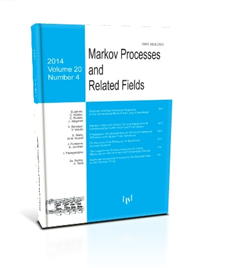A Spatial Epidemic Model with Site Contamination
T. Britton, M. Deijfen, F.M. Lopes
2018, v.24, Issue 1, 25-38
ABSTRACT
We introduce the effect of site contamination in a model for spatial epidemic spread and show that the presence of site contamination may have a strict effect on the model in the sense that it can make an otherwise subcritical process supercritical. Each site on $\mathbb{Z}^d$ is independently assigned a random number of particles and these then perform random walks restricted to bounded regions around their home locations. At time 0, the origin is infected along with all its particles. The infection then spread in that an infected particle that jumps to a new site causes the site along with all particles located there to be infected. Also, a healthy particle that jumps to a site where infection is present, either in that the site is infected or in the presence of infected particles, becomes infected. Particles and sites recover at rate $\lambda$ and $\gamma$, respectively, and then become susceptible to the infection again. We show that, for each given value of $\lambda$, there is a positive probability that the infection survives indefinitely if $\gamma$ is sufficiently small, and that, for each given value of $\gamma$, the infection dies out almost surely if $\lambda$ is large enough. Several open problems and modifications of the model are discussed, and some natural conjectures are supported by simulations.
Keywords: spatial epidemic, interacting particle system, phase transition, critical value
COMMENTS
Please log in or register to leave a comment

